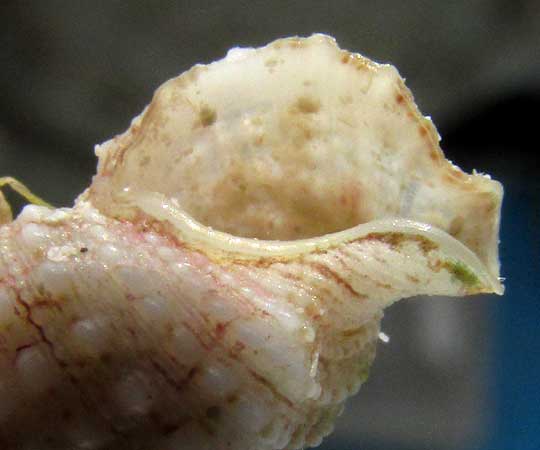Excerpts from Jim Conrad's
Naturalist Newsletter

from the May 24, 2015 Newsletter issued from Río Lagartos, on the Yucatan Peninsula's northern coast (~N21.60°, ~W88.16°), Yucatán state, MÉXICO
FLYSPECK CERITH
A couple from Iowa wanted to try the Maya Mud Bath, in which a certain mud the Maya use as a sunscreen and skin beautifier is smeared over the body, so at the end of the flamingo-viewing tour we pulled up to the mud bank, the Iowans went for their mud, and I was in the boat staring at the water.
The water next to the boat was about finger-length deep and the submerged mud was carpeted green with tongue-shaped Caulerpa prolifera alga, exactly as shown at www.backyardnature.net/n/15/150208cb.jpg.
Just to have something to do I slid my finger across the mud between the bases of the alga blades, until something interesting was felt, and retrieved. It was a living gastropod-type mollusk, small but pretty, only about 18mm long (2/3inch), shown at the top of this page.
I took the time to look closely at the highly ornamented shell. Notice how it's organized into eight or nine major whorls, with each whorl bearing three rings of low "teeth," with the teeth lined up lengthwise. Between the teeth are irregularly appearing tiny brown specks. The shell's most elegant feature is the opening, or "aperture," inside which the mollusk has withdrawn its rubbery flesh. A close-up of the aperture is shown below:

Volunteer identifier Bea in Ontario came up with the name CERITHIUM MUSCARUM for the creature, sometimes known as the Flyspeck Cerith. The flyspecks are the tiny, brown spots between the shell's low teeth. Some shells display much more conspicuous and well ordered specks, but some shells show fewer. The Flyspeck Cerith is one of three Cerithium species listed for Ría Lagartos Biosphere. The species occurs from North Carolina south throughout the Gulf of Mexico and much of the Caribbean possibly as far south as Brazil. In Florida it's regarded as the most common Cerithium species.
Several crab species and a variety of gastropod mollusks are known to prey on Flyspeck Ceriths, and stingrays and horseshoe crabs are suspected as predators. Flyspecks are described as inhabiting shallow intertidal to subtidal zones, typically occurring in water less than leg deep, sometimes on naked mud but often in seagrass beds similar to where ours was found.